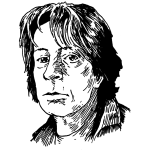Richard Price published his first novel, The Wanderers, in 1974, when he was just twenty-four years old. With his youth, his floppy, Pacino-esque mane, and his schizoid deadpan dialogue, Price was an instant lit “it” boy. Price continued to publish novels (Bloodbrothers; Ladies’ Man; The Breaks), but for the most part he stuck with screenplays, writing The Color of Money (“The ball rolls funny for everyone, kiddo”) and Sea of Love (“Come the wet ass hour, I’m everybody’s daddy!”). He even scripted the Scorsese-directed Michael Jackson video for “Bad.”
In 1992, Price published Clockers, a massive, self-conscious, and wry page-turner set in the fictional slums of Dempsy, New Jersey. Here was something new: a novel about life in the projects, told from the perspective of both sides of the law, written by an Ivy League–educated Jew from the Bronx. Clockers landed Price on a memorable two-part special edition of Nightline in which the writer escorted Ted Koppel to the Jersey City projects where, as research for the novel, Price had hung out with cops and coke dealers—a dangerous endeavor for any writer, even one who cut his teeth on the streets. “I got out of the car and I heard, ‘He’s a cop!’” Price said of that time. “I thought, Oh, oh. This is it. I have two daughters and I’ve finally gone too far.”
Price followed Clockers with two more massive books, Freedomland and Samaritan—a kind of straight-from-the-streets trilogy totaling 1,673 pages, set almost entirely in Dempsy. Since then, aside from writing a few teleplays for The Wire, Price has kept busy researching a new novel. Lush Life, out earlier this year, contains some of Price’s most poetic and emotional writing to date. Now fifty-eight, he says the book caused him to look in the mirror and see what’s what as he slips deeper into middle age. “There’s nothing worse than an aging enfant terrible,” he told me.
I met with Price at noon on a winter day, in his spacious townhouse located on a noisy street near Gramercy Park in Manhattan. When he opened the bright red front door, he poked his head out, looked right, looked left, scoping out the street scene before chinning me inside.
We talked for two and a half hours straight, sitting side by side on a lumpy sofa in his office, near a wall-to-wall filing cabinet. When I asked after the contents of the drawers, Richard rolled his eyes. “Just some crap,” he said.
—Alec Michod
I. “TERROR KEEPS YOU SLENDER.”
THE...
You have reached your article limit
Sign up for a digital subscription and continue reading all new issues, plus our entire archives, for just $1.50/month.
Already a subscriber? Sign in





